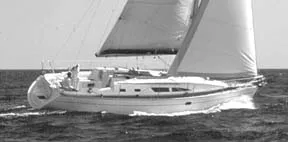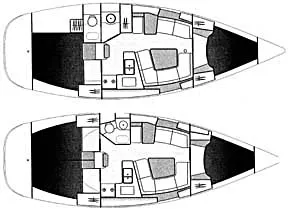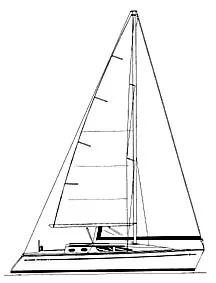A relative newcomer with a sporadic history in the American marketplace, Jeanneau was founded in France in 1956 by Henri Jeanneau, whose primary emphasis was building powerful motorboats. It did not begin producing sailboats until well into its second decade of operation.
Like many builders of that generation, Jeanneau in the 1980s became something of an industry orphan. Sold first to Bangor Punta, which also owned Cal and O’Day, it was re-sold to Chatellier Industrie, and later, in 1995, to the Beneteau Group.
Though operating under the same corporate umbrella, Beneteau and Jeanneau have retained their individual identities, like General Motors products, though they share technology and efficiencies in the purchase of raw materials.

Jeanneau currently builds 4,000 boats annually at its plant in Les Herbier, France, of which 1,200 are sailboats ranging in size from 17′-52′. The Sun Odyssey line is aimed at cruisers, the Sun Fast line at performance-oriented sailors. But the Sun Odysseys, including the 37 reviewed here, are hardly traditional cruisers, what with their fin keels, spade rudders and light displacement. Then again, we’re talking coastal cruising, not serious bluewater passagemaking.
Mainstream is where the sales are, and the Beneteau-Jeanneau combination is the largest sailboat manufacturer in the world, reporting gross sales of more than $300 million annually.
Design
Like its predecessor, the Sun Odyssey 36.2, the new 37 was designed by Jacques Fauroux and the Jeanneau design team using CAD-CAM tools. While the 37 is longer, it has 4″ less beam, and carries about 15% more sail area. The 37’s lines are characterized by an almost flat sheer, low profile cabintop that slopes gently forward and arthwartship, short bow and stern overhangs and a reverse transom.
With its emphasis on the cruiser market the SA/D (sail area/displacement ratio) is only 15.56, a function of a moderate sailplan that carries only 315 sq. ft. in the main, and 414 sq. ft. in a 130% genoa.
The displacement-length ratio is a fairly light 188 and the length-beam ratio is 3.08, which means she’s beamy and relatively flat-bottomed. This suggests considerable initial stability, and a boat that likes to be sailed as level as possible.
No PHRF handicap has been established for the 37 as of this writing because the boat is too new.
Construction
In the mid-1990s Jeanneau became the first French boatbuilder to receive European ISO 9000 certification, a standard that documents each step of the production process and assures purchasers that each boat meets a specific production standard.
The 37’s hull, according to Paul Fenn, president of Jeanneau North America, is solid, hand-laid fiberglass with Kevlar reinforcements in high-load areas surrounding the keel and mast step. Vinylester resin is used in the outer plies of the laminate to help prevent blistering.
The boat is built without molded interior liners. To provide stiffness, there is a grid of longitudinal hardwood stringers and floors encapsulated in fiberglass and glassed to the hull. This also makes a framework for the sole, floorboards and cabinetry. Bulkheads are bonded to the hull in channels and secured with Sikaflex.
In a departure from the 36.2, the headliner is glued to the underside of the deck and is not removable. Except for wiring for halogen ceiling lights, however, we found wiring and plumbing runs accessible behind interior cabinetry and beneath floorboards.
The hull/deck joint consists of an inward-facing flange at the top of the hull that is glued to the deck with Sikaflex. Then the toerail is mounted over the deck and screwed in place, strengthening the joint and hiding the seam. We prefer the combination of bolts, nuts and washers employed on the 36.2.
The deck is laid up with fiberglass cloth and cored with balsa, except in high-load areas, which are solid fiberglass.
Two keels are available in North America—a deep fin with a 6′ 4″ draft, or a heavier shoal draft version that draws 4′ 9″. Both have bulbs at their tips. Ballast is iron, which is not as good as lead because it is less dense and difficult to keep from rusting. The factory-applied epoxy coating should be diligently monitored and maintained.
The rudder is tall and narrow, typical of today’s performance boats, and made of fiberglass with a stainless steel stock. The rudder shaft is adjusted by two self-aligning bearings.
The engine beds are hardwood/fiberglass stringers into which the engine is secured with lag bolts. A molded pan underneath the engine prevents oil spills from flowing into the bilge.
Standard equipment includes a fuel/water separator, raw water filter, anti-siphon valve and maintenance-free stuffing box.
Jeanneau’s warranty is five years on the hull and deck.
Deck Layout
The mast, boom and deck hardware are supplied by a diverse group of American and European manufacturers. The double-spreader rig is by Z-Diffusion. The spreaders are swept aft 21°. Tracks by Amiot for headsail sheeting are located well inboard, along the cabin, which should help windward performance.
The single upper and single lower shrouds are led to a single stainless steel deck plate; rigging loads are transferred to the hull via stainless steel rods through-bolted to wood structures glassed to the hull. Standing rigging is 1 x 19 wire.

The split backstay is essentially non-adjustable. One could rig a pair of blocks and tackle to squeeze the stays together, which would rake the masthead aft and tension the forestay. But this boat is a bit big for this small boat trick. The purpose of the split backstay, of course, is egress from the swim platform to the cockpit.
Walkways forward are 17″ wide. The double lifelines are 25″ high. Additional handholds are 68″ teak rails running from the companionway to the shrouds.
A 2″ high anodized aluminum toerail provides additional security. However, we’re puzzled that it is not perforated, a feature that allows you to shackle snatch blocks for varied sheeting angles, and quickly drains water overboard. Jeanneau’s solid toerail must be more for style.
The bow pulpit is 28″ high and is cleverly designed so as not to be in the way when hoisting anchor. Aiding in this matter, the Profurl furling drum is 26″ above the deck, so is also out of the way of anchor and rode coming aboard.
The stainless steel stem fitting has double bow rollers, and there is a deck-mounted Lofrans windlass that one could consider relocating to the 37″ deep by 30″ long anchor well, just to clear the foredeck.
The steering system is by French-maker Goiot Innovations; the pedestal is bulkier than we’re used to seeing, perhaps a reflection of a marketplace gone gaga over instruments. Our test boat was equipped with a 36″-diameter stainless steel destroyer-type wheel; a larger diameter wheel would make it easier to steer from the rail. An optional folding table mounts on the front of the pedestal.
Considering its 35′ length on deck, the Sun Odyssey 37 has an enormous cockpit, especially with the table down. Seats on each side are 74″ long, 16″ wide, with 12″ backrests, except in stern quarters where backrests are only 7″ tall. The seats are covered with teak and the backrests angled outboard, which provide excellent lumbar support. A teak strip on the centerline of the cockpit sole provides a footrest when heeled. This is very important on today’s beamy boats where the opposite seats are too far away to reach with your feet.
Running rigging lines lead aft through turning blocks to Spinlock XA and XT sheetstoppers mounted atop the coachroof. Winches are Harken two-speed, self-tailing 32s; primary genoa winches are Harken 44s.
Those who think it is impossible to have too much space in cockpit lockers will relish this cockpit. The 44″ deep x 57″ long (at its shortest point) x 42″ inches wide port lazarette is nearly large enough to serve as a berth; it is handy for storage of an inflatable raft or sails.
The emergency tiller stows in a second area, 25″ x 48″. A third slightly smaller area will take hatchboards and smaller items.
Propane tanks are located in the port corner and vented overboard per ABYC standards.
A unique touch is that the helmsman’s seat accesses the swim platform by folding downward until it is flush with the deck; we think that’s an improvement over seats that tilt upward, which may require a crew to move, or may unexpectedly close.

The three-rung, stainless swim ladder is permanently attached to the swim platform and secured by bungee cords; it extends 20″ below the water’s surface, but would benefit from a handle for reentry to the boat. The swim platform is 15″ long, 60″ wide, and is equipped with a handheld shower.
Accommodations
Two interiors are offered, a three-cabin model popular in Europe with charter operators, and the two-cabin version we tested.
The two-stateroom model has a double berth in the starboard quarter and a head to port, both of which are larger than those in the three-cabin version, which has mirror-image staterooms aft. The skipper’s stateroom in the bow is identical in each model.
There is no bridgedeck. Stepping over the 12″ companionway sill and down 14″ to the ladder takes some getting used to. The four curved wood steps are covered with nonskid tape and there are handrails to each side of the companionway. A finger rail running the length of the saloon adds a good handhold.
Headroom is 6′ 3″.
We are impressed with dramatic improvements in the fit and finish of cabinetry and wood surfaces.
Jeanneau has historically purchased, dried and milled its own lumber. Fenn told us that the company recently invested more than $1 million to purchase machinery that sands, seals, dries every piece of wood on the boat, then applies three uniform coats of varnish. Wood components are then cut to close tolerances by computerized saws; edges are finished by hand.
The cabinetry on the boat we inspected reflected close attention to detail with smooth, well-finished surfaces and tight joinery.
There are Goiot hatches over the saloon and forward stateroom, and four portlights on each side of the cabin.
The starboard stateroom has 6′ 4″ headroom, a rectangular 84″ x 81″ berth, a 17″-wide hanging closet and 12″-wide storage compartment. Two 11″ x 4″ ports in the hull and an opening port in the cockpit footwell supplement ventilation.
Most of the space below the berth is designated for plumbing and wiring, battery storage, and a fuel tank. An inspection port for the stainless steel tank is precut in the storage cover.
The L-shaped galley is forward of the stateroom in a space uniquely defined by a 50″ long piece of custom glass 9″ high running along the forward edge of the counter, a nice accent. Otherwise, the galley is rather ordinary, but large enough to be functional. It is equipped with a 40-gallon ice box with 12-volt refrigeration and Force 10 four-burner stove with oven.
The head and nav station are located opposite the galley.
The spacious head has two compartments separated by a Plexiglas® partition. The 28″ x 37″ shower compartment is aft. The toilet is by Jabsco.
The nav station has been repositioned to face forward, overcoming an objection we had to the 36.2. Cabinets and shelves provide space for radar, VHF, stereo, GPS and chartplotter, and books, binoculars and other tools.
In the saloon, the C-shaped dinette seats four adults. The mast compression post, located at the forward end of the table, is well camouflaged with a gray leatherlike material. The settee converts to a 74″ x 48″ berth.
A second settee to port measures 65″ x 24″.
Forward, the master stateroom berth measures 85″ wide at the head and 81″ long. The 85-gallon water tank is located underneath. Reading lights, a port overhead and shiny gelcoat surfaces provide and reflect light.
Performance
Our test was arranged by Don Durant, president of Cruising Specialists in Alameda, California, a longtime Jeanneau dealer who also places them in a charter fleet.
He handed us the keys to the engine, gave directions to San Francisco Bay, and sent us on a singlehanded excursion.
The 27-hp. Yanmar diesel outfitted with a two-blade fixed propeller powered the boat in smooth water at 5-6 knots.
The Sun Odyssey 37 turns easily within a boat length and, more importantly, backs in a straight line, as we discovered when forced to back into a space between two anchored boats.
Because we were singlehanding, we appreciated the optional in-mast mainsail furler, and standard headsail furler. Both sails were flying within 30 seconds of reaching the sailing grounds, assisted by a pedestal lock that held the boat on a straight course.
Sailing in 5-11 knots of wind, we managed to sail closehauled at 4.5-5.3 knots. The helm is very responsive and the boat accelerates quickly out of a tack. The 37 sails to within 35°-40° of apparent wind and the compass indicated she tacks through 85°-90°.
We reached similar speeds on a close reach and discovered that she’ll bury her shoulder and sprint forward at 120° of apparent wind.
However, we think the boat is capable of significantly better performance. Our test boat was even more undercanvassed than the standard rig; the in-mast mainsail furler necessarily results in a small, roachless mainsail, and the genoa furler was tacked 26″ above the deck.
We’d prefer to pile on the sail and reef when necessary; we would especially like to sail this boat fully crewed with a spinnaker in steady 20 knot breezes.
Movement about the cockpit was effortless; we moved in two steps from the wheel to winches and sail controls on the cabintop. Genoa sheets were within reach from the wheel.
Conclusion
The Sun Odyssey 37 is manufactured to exacting standards by a major builder supported by an extensive dealer network, North American service department, and five-year warranty.
She’ll provide casual cruisers with performance equivalent to her major competitors, and will reward an investment in quality sails and good crew work with more exciting sailing.
She’s equipped with deck hardware that is well organized and easy to manage from the helm, though we’d consider a larger wheel. In the years to come, replacement of some foreign hardware may be difficult.
Our preference is the two-cabin arrangement, which provides berths for six adults and has a more spacious head.
The nav station is larger than those found on similarly sized boats. The galley is compact but functionally adequate. There’s storage space throughout the boat, including hanging lockers large enough for dry and foul weather gear.
Engine power is adequate for most coastal sailors. Cruisers may want to consider the addition of an optional water tank located in the aft stateroom.
The Sun Odyssey 37 seems reasonably priced at $115,000 FOB the East Coast. Expect to add $10,000-$15,000 for instruments and options. For comparison, the Dufour 36 starts at $141,000, the Tartan 3700 at $186,000, and the Beneteau 361 at $110,000.
Contact- Jeanneau North America, 105 Eastern Avenue, Annapolis, MD, 21403; 410/280-9400; www.jeanneau.com.
































